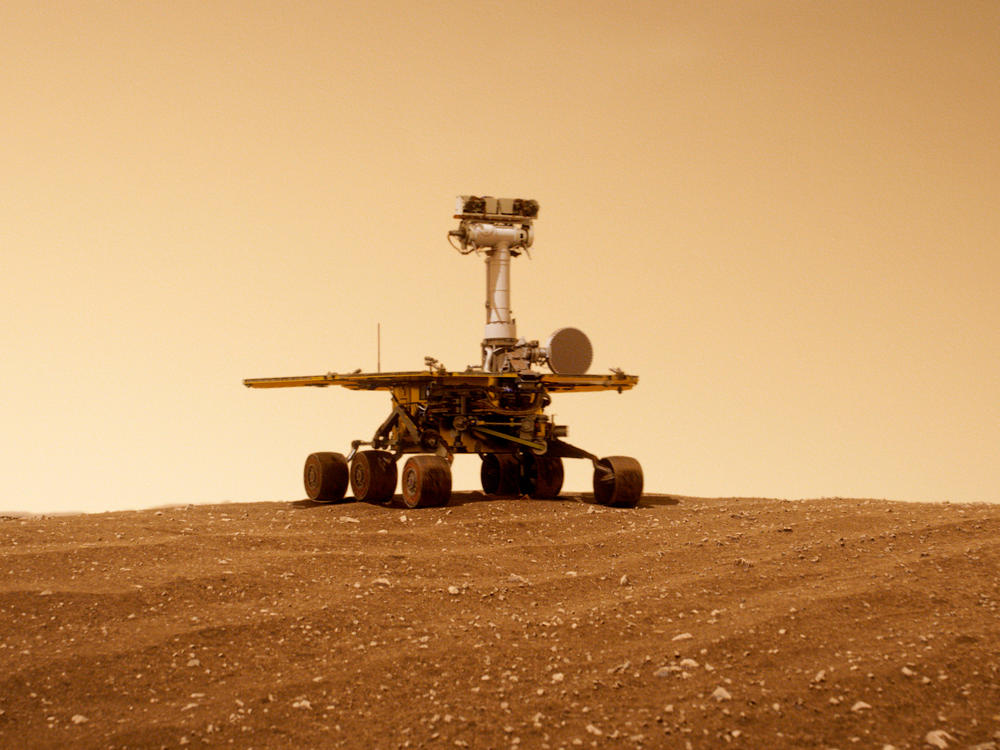Section Branding
Header Content
A loving salute to NASA's Mars rover program in 'Good Night Oppy'
Primary Content
Updated November 4, 2022 at 12:44 PM ET
When first spotted, Oppy has been on a roll but has abruptly come to a stop. "Hazard detected," she alerts her handlers on earth. They get the message some six minutes later, look at the image she's sent, and send back a few words that get her rolling again: "You are safe to proceed. That's just your shadow."
Now, forgive me, but this is not even four minutes in, and already I'm hooked.
In 2003, NASA sent two robots — Spirit and Opportunity – to explore the surface of Mars. The solar-powered and semi-autonomous rovers were expected to have a lifespan of about 90 days. But as chronicled with invention and enormous charm in Amazon's documentary Good Night Oppy, they continued sending back data and pictures for years.
"To say it's like a child being born would be to trivialize parenthood," says mission manager Steve Squyres early in the film, "but it feels sorta like that."
Oppy and her twin sister Spirit, look like real-life Wall-Es. They each have solar-panel wings to provide power, metal arms to pick stuff up, and a head that swivels with lenses spaced just like a person's eyes. They stand 5 feet, 2 inches, and every morning, NASA's scientists rouse them from an overnight slumber just as they did their human counterparts on manned space flights.
The story of how they were conceived, designed, tested, and sent to Mars fills the first half of Good Night Oppy, and it's a suspense-filled ride, crammed with brainstorming, trouble-shooting, deadline-pushing, and frequent nail-biting. Tight scheduling meant engineers needed to invent solutions on the fly when, say, balloons meant to cushion the rovers' landing burst on impact during tests. And even after launch, there were problems to be overcome. Solar flares corrupted the rovers' software as they rocketed toward Mars, requiring an unexpected reboot in mid-flight.
Still, seven months and 300 million miles later, they get to the Red Planet and the real fun begins. The filmmakers have plenty of footage of NASA folks cheering, fretting, and most of all, explaining. The director also employed the digital wizards from Industrial Light & Magic to conjure the scenes on Mars that his crew can't shoot: the rovers, for the first 90 days racing against time as the scientists assume their solar panels will get so dusty they'll no longer provide power.
Then came what appeared a mission-killer of a problem: Whirling mile-high tornados of dust. But to the astonishment of the scientists, when the dust cleared, the solar panels had been scrubbed clean and were as spotless as the day they'd landed.
A new lease on life, repeated again and again, as the rovers spend years exploring terrain NASA never expected them to see. Over time it makes sense that the scientists and engineers would view their charges as almost human, lamenting, say, how dust had corrupted Oppy's "arthritic" shoulder joints. A technician who'd given birth to twins of her own as she began sending remote signals to drive the twin rovers, noted differences in their capabilities, and personalities. A scientist dealing with her grandmother's dementia sensed similarities in the way that software memory loss was impeding the rovers' information gathering.
Only natural. They'd birthed the rovers after all, and sent them out to fend for themselves, hoping they'd imparted the skills necessary to stay safe and to thrive. And when their mechanical charges overcome obstacles or exhibit unexpected stamina and pluck, their handlers respond like the proud parents they are.
Watching Good Night Oppy, you'll likely feel that way, too — proud and fond of these intrepid explorers who may not have found life on Mars, but who ensured, for 15 years at least, that the Red Planet was lively.
Copyright 2022 NPR. To see more, visit https://www.npr.org.

